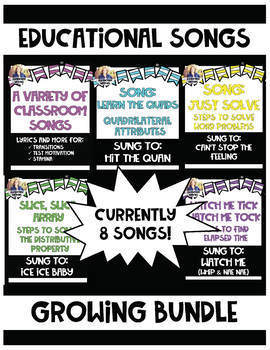Learning Songs for the Classroom *Growing Bundle*
- Zip
Description
Have you ever had a song stuck on repeat in your head? Can’t stop the words from running over and over? Of course! So, why not use songs in the classroom?
SAVE WITH THIS BUNDLE! ALL ON MY SONGS IN ONE PLACE!
This bundle includes the following products:
Songs for the Classroom
-1 transition song (What Do You Mean)
-2 motivational songs (Shine Bright Like a Diamond and We Will Rock You)
-1 stamina song (The Greatest)
Song for Distributive Property Steps (Ice Ice Baby)
Song about Quadrilaterals' Attributes (Hit the Quan)
Song for Elapsed Time (Watch Me/Whip Nae Nae)
Song for Solving Word Problems (I Got This Feeling)
Year after year my kiddos love singing in class. We've even performed some of the songs at our school’s talent show! The best part, is when students recall the lyrics while working and even state testing! I hope you and your students enjoy these songs as much as I have! Free to contact me with ANY questions. :)




